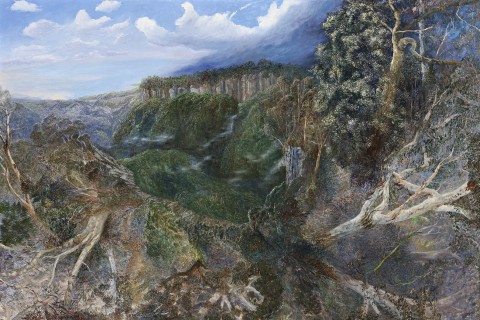WATTLE TREES WITH APPROACHING STORM, 2003
WILLIAM ROBINSON
oil on linen
122.0 x 183.0 cm
signed and dated lower right: William Robinson 2003
dated and inscribed with title verso: WATTLE TREES WITH APPROACHING STORM. 2003
Philip Bacon Galleries, Brisbane
(label attached verso)
Private collection, Brisbane
Private collection, Sydney
William Robinson: Paintings and Pastels, Philip Bacon Galleries, Brisbane, 12 August – 6 September 2003, cat. 3 (illus. in exhibition catalogue, p. 11)
By the time William Robinson came to paint Wattle Trees with Approaching Storm, 2003, he was well established as a great Australian landscape painter. With four of Australia’s most prestigious art prizes to his name (two Archibald and two Wynne prizes) as well as thirty solo exhibitions, the artist had every right to feel comfortable with the mantle. Robinson broke the mould when it came to painting the Australian landscape. Where many artists of his generation chose to look inwards towards the outback’s desperate beauty, Robinson focussed almost entirely on the ancient rainforests and eucalypt forests of south east Queensland.
His progress as a painter is easily charted as each of the artist’s exhibitions trumpeted his latest innovation or discovery. By the time of his 2003 exhibition, which included Wattle Trees with Approaching Storm, the artist’s trade mark staccato brush work had given way to a more contemplative, patient method of applying the paint. The urgency to capture the moment and draw it to a towering crescendo had given way to a rhetorical meditation on the picture itself.
In the title Wattle Trees with Approaching Storm, Robinson points us to the actual subject within the broader context of the landscape. Wattle trees flower following the winter solstice and those growing nearest the coast flower first. They signal that the earth has begun to pivot north, the sun is rising earlier and spring is approaching. Robinson presents this optimistic moment, but then tempers it with the approaching storm. In the centre of the work we see light mist dipping deeper into the valley as the barometric pressure drops and the approaching storm rolls in over the cliffs. In a dramatic overture, the front of the painting appears to reach out to envelop the viewer. The subsequent vacuum effect draws the eye in towards the centre of the composition and down through the painting toward the distant coast. Robinson’s paintings attempt to create the sensation of being in the landscape and in the passage below the artist explains the feeling he attempts to convey:
'I want to move away from observing the picture as some sort of representation. I want to sweep the observer down gullies and up into the sky. The observer is drawn into the landscape not physically but as a sort of connection to memory. The painting reminds us of experiences we might have had when walking in the bush ... I am only presenting personal experience to be shared, but I would like to give some clues that may help the observer to experience the picture.'1
The sensation when viewing these fuller, later Robinson paintings is one of contentment. The artist’s enjoyment, confidence and wonder at what he has achieved as a painter is easily felt in the finished paintings. The near conventional perspective in later Robinson landscape paintings is, in itself an innovation when compared to the turbulent compositions with which the artist established his reputation.
1. Seear, L., Darkness and Light, The Art of William Robinson, Queensland Art Gallery, Brisbane, 2001, p. 118
HENRY MULHOLLAND
